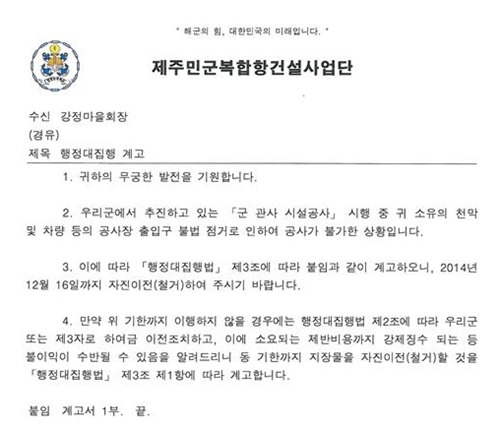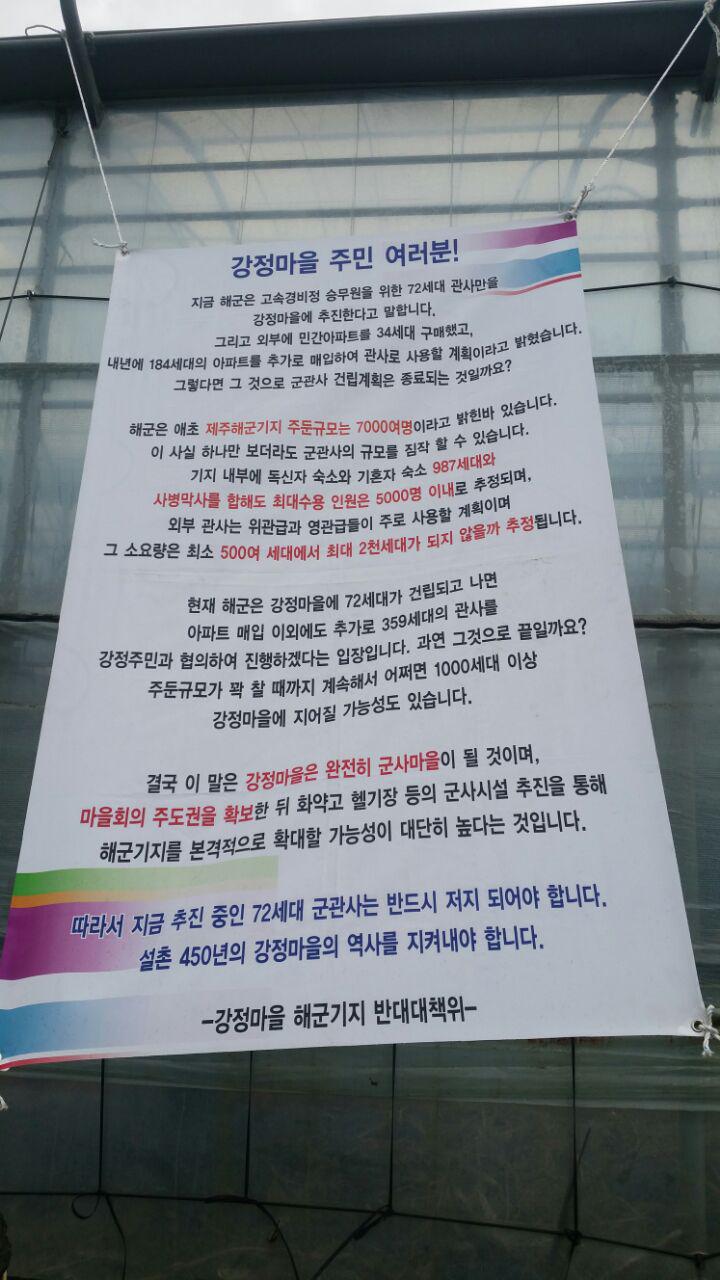
Since November, people have taken 24 hours sit-in in front of the military residence construction area inside the village. A big sit-in tent and village bus block the whole main gate of it. (Photo by Park Yong-Sung)
People resist to the lying navy who enforces the building of military residence inside the village
Admiral Hwang Ki Chul, the incumbent chief of Naval Operations of the Republic of Korea Navy since September, 2013, who is recently denounced for his scandalous involvement in the corrupt arms purchase from an unknown US arms company years ago (see here), has made a remark that the navy would never build military residence inside the Gangjeong village unless villagers agree with it. His lie still loudly rings to the ears of people who clearly remember what he said.
But as Kim Sung-Chan, one of his predecessors, has later violated his own words that the navy would never expropriate villagers’ lands and would never start base construction without villagers’ agreement, Hwang and the navy has been setting to build 72 households of military residence on the way to the port inside the village, without consultation and agreement with the villagers (for more on the navy plan of military residence and people’s strong opposition to it, see the top articles of Oct. and Nov. newsletter, here and here.)
As soon as the navy got permission from the Seogwipo City Hall on Oct. 7, this year, it moved two containers into the military residence construction area for 72 households, set up the fence, and installed surveillance camera on the top of its main gate.
The navy’s enforcement of the military residence construction started along with the setting for the construction of a cruise terminal which is a part of so called ‘Civilian-Military Complex Port for Tour Beauty Project,’ an official name of the Jeju naval base project, ridiculous though as the navy seems to prefer to a ‘pure’ navy base. The location of the latter is much nearer to the port. Signs of construction information for those swarm along the way to the port where one does not miss a scene of the transformed coast and sea covered with ugly base construction facilities and monster-like pollution-pouring barges.
With urgency to save the 450 year old village from the building of military residence inside the village, people have begun to stop construction vehicles going to the area with 24 hours’ sit-in booth in the center road of the village and later on, with a large sit-in tent just in front of its main gate. The only village-owned bus was tightly chained next to the sit-in tent, totally blocking the whole gate from all the construction vehicles.
Now, the sit-in tent site just in front of the military residence construction gate is people’s another struggle fronts along with the base construction gate site in the eastern part of the village and Samgeori(a three-fork road) where people have set a communal restaurant and residence containers for the purpose of occupation against navy’s robbing-off the area.
Budget was passed with an unreliable condition, ‘Occasionally allocated’
Despite people’s clear demand to cut the whole 2015 Jeju naval base budget, especially that of military housing project inside the village (for the details, see here), it was on Dec. 2 when the South Korean National Assembly passed the whole 2015 Jeju naval base budget of 298 billion won (about 290 million USD), but with the decision to compile the budget as the ‘occasionally allocated,’ which means the budget is compiled and managed by the Ministry of Strategy and Finance which would hand over the budget to the Ministry of National Defense whenever ‘a condition’ is implemented.
The Jeju Island government stated on Dec 3 that the National Assembly condition meant an agreement between the navy and Jeju Island Government which had requested the former not to build military residence inside the village, following the result of its meeting with the representatives of the village association last month(see the headline article in Nov. newsletter, here). The Island government even stated that the execution of budget for the building of military residence became impossible for the navy without consultation with the Island government. It stated that it would do its best to consult with the navy so that the navy could purchase military residence in nearer and better location rather than building it in the currently planned site inside the village.
However, no matter how confident the Island government appears in regards to its interpretation on the ‘occasionally allocated budget,’ such condition is not clearly written as a collateral condition to the budget passed by the National Assembly. Doubts are reasonably raised on such budget allocation, given that the Ministry of National Defense, and the Central Governments have never observed such National Assembly condition even in written forms. The Government-specifically the Ministries of Strategy and Finance and National Defense could be very arbitrary in its decision to allow the execution of the budget and to execute it respectively.
(See a reference article in a Jeju media in Korean, here)
The Navy’s shameless warning to dismantle people’s sit-in tent

As the date of Dec. 9, 2014, the navy sent the village mayor the 1st warning notice to dismantle people’s sit-in tent and other sit-in facilities by Dec. 16, in the name of the Jeju Civilian-Military Complex Port Building Committee.
Otherwise, on Dec. 10, the Jeju naval base project committee sent a written warning to the village association that it would carry out an administrative vicarious execution which means it would dismantle people’s sit-in tent and village bus unless the village association is volunteering to remove it by Dec. 16. The warning even threatens villagers that they may be even enforced to pay all the execution fees.
The notice was recently sent again to the village with the due date by Dec. 22. Barbarous however the navy’s plan is, a lawyer tells on the legal matter. According to the lawyer:
‘Even though there is an issue of violation of Constitution when a special group so called military directly carries out an administrative vicarious execution against general citizens, which oppresses their right to property and freedom, it has an authority on an administrative vicarious execution by the positive law, in cases the state or local self-governing organization is an enforcement administration of the applied construction.’
The village association, confirming its will to fight against any outside oppression, declared that it would keep the sit-in tent and other sit-in facilities to the end. The Seogwipo City to which the village belongs to, has not cooperated to the navy in regards of dismantling villagers’sit-in tent, as the City is under the order of the Island government.
The village denounced the navy saying that military residence building project denies the local residents’ right to self-governing decision and the existence basis of the village association. Not only that, it is an explicit extension of the Jeju naval base project, not to mention that it seriously threatens the villagers’ right to live. (see the collection of the articles on the navy letter and villagers’ protest statement in Korean here)
The Jeju Pan-Island Committee for the Stop of military Base and for the Realization of Peace Island, which is composed of 31 parties, civic groups, and religious groups within the Jeju Island, denounced the navy in its Dec. 12 statement, saying that “it is exposed that the navy’s showy rhetoric by now such as ‘agreement by villagers,’ ‘conflict settlement,’ is merely a kind of a ‘false psychological war,’ which intends to mislead public opinion on the basis of military operation.’
It is not clear yet when the navy would finally carry out its administrative vicarious execution, mobilizing its thugs and police.. Is the navy who has used sugar-coating words such as ‘co-existence of civilian-military’ and ‘civilian-military complex,’ willing to clash directly with the people? The time is approaching.
And regardless of the navy’s shameless deeds, people keep their 24 hour sit-in in the tent. A peace activist writes:
“Whatever, the politics, administration, and media do, there may not be much we can do. We have only our bodies and hearts. Nothing to be changed. We continue to sleep in the tent, clean it, perform traditional music, watch movies inside it, pack tangerines for fundraising, file fire woods, make fires in furnace, and stop vehicles with our bodies… regardless the navy comes to dismantle our sit-in tents whenever…”

People lightens a whole night with fire in front of the military residence construction area on Dec. 18 (Photo by Kim Eun-Hye)
(See here for more photos)
To save the village and to realize a true Peace Island, people’s fight will never end. A new year is approaching: The 10th anniversary of the Jeju designated as the “Peace Island’ by the Government.

Protest banners are hung inside and even neighborhood village . The banner reads, “Navy! you are the outside power that destroys our hometown, Gangjeong! – Anti-navy base committee of the Gangjeong village” Choi Yong-Beom, Co-vice mayor of the village and a peace activist (Photo by Park Yong-Sung)

A banner by the anti-naval base committee of the Gangjeong village, hung inside the village. The navy plans to station about 7,000 people in the Jeju naval base that is currently being built. You may remember that the whole population of the Gangjeong villagers is less than 2,000. The banner explains the urgency of the struggle to stop the navy’s current project to build 72 households of military residence outside of the base but inside the village. (A photo by Choi Yong-Beom, Co-vice mayor of the Gangjeong village)
A rough translation of the banner above:
“Gangjeong villagers!
Currently the navy is saying that it is driving only for 72 households for patrol boat crewmen. And it stated that it has already purchased 34 households of civilian apartment in the outside and it would additionally purchase 184 households of apartment next year to use those as military residence.
Then, will the navy’s military residence construction plan end only with it?
The navy has originally stated that the numbers of people who would station in the [currently being built] Jeju naval base would be 7,000.
Only with that fact, you can roughly guess the size of military residence. It is estimated that the maximum numbers of people who would be accommodated [in the currently being built military residence] inside the base would be no more than 5,000, even with combining all the numbers of people in 987 households for the singles and married, and of enlisted men’s barracks. It is planned that the military residence outside of the base would be mainly used by the company and field grade and it is estimated that the required numbers of the households for those would be around 500 at the minimum to 2,000 at the maximum.
The navy’s position is that once 72 households are constructed in the Gangjeong village, it would, consulting Gangjeong villagers, progress building of additional 359 households, beside the purchase of apartment, . Do you think that is indeed the end? There is possibility that more than 1,000 households of military residence would be continuously built in the Gangjeong village until the size of stationing people fulfills.
In other words, the Gangjeong village would be totally a military village as a result of it. It will be very likely that the navy would secure the initiative of the village association then extend the naval base in earnest through driving for military facilities such as magazine powder keg/ heliports.
Therefore, the navy’s current drive to build 72 households of military residence must be stopped. We should save the history of the 450 year old Gangjeong village.
The anti-naval base committee of the Gangjeong village




